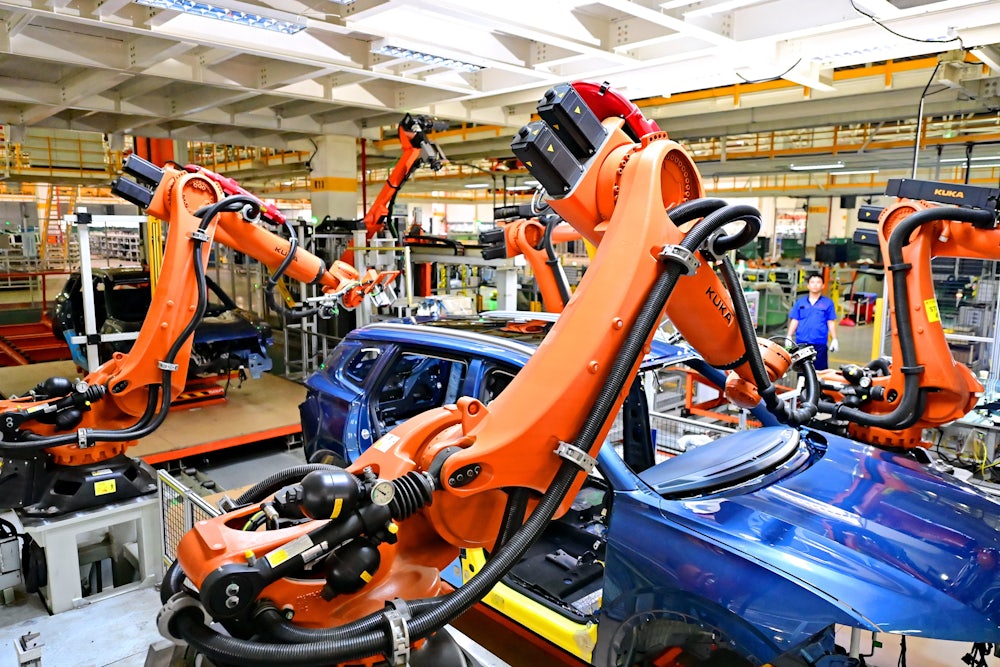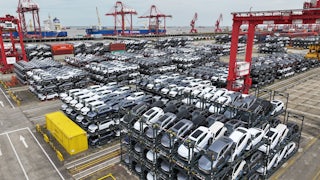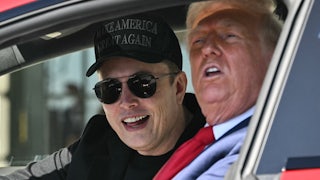The White House is trying to strike a difficult balance: Saving the climate, which the Biden administration says it wants to do, may conflict with the administration’s industrial policy and foreign policy goals—and particularly its goals during an election year.
In theory, reducing emissions quickly would require importing as much clean technology as quickly as possible. Doing that, however, stands to devastate politically important industries, leave global supply chains for things like solar panels and electric vehicles even more heavily concentrated in China, and court political backlash that might help Republicans, who are eager to torpedo anything that smacks of climate policy.
So this week, the administration announced that it will quadruple tariffs on Chinese electric vehicles to 100 percent and raise tariffs on Chinese-made solar cells to 50 percent. A slew of other goods from China will face higher levies too, amid increasingly loud calls from both sides of the political spectrum to wage what would amount to a trade war with the world’s second-largest economy.
Biden and several Democratic congressional candidates face uphill fights in key, carmaking battleground states like Michigan and Ohio. The practical effects of the tariff hikes announced this week should be relatively modest: Chinese-made E.V.s were already subject to a 27.5 percent tariff, and only one company—Polestar, owned by the Chinese firm Geely—currently imports electric vehicles from China to the United States, which make up a very small percentage of the still relatively small overall percentage of E.V.s sold here. How exactly China will respond to last week’s tariff news isn’t exactly clear. It may be more concerned about the European Union taking inspiration from the U.S. and instituting protectionist measures of its own.
For argument’s sake, let’s ignore some of the more bombastic, hawkish rhetoric coming out of the White House and accept a minimalist, somewhat charitable explanation for these tariffs: that they’re a means to buy U.S. automakers time to catch up to foreign competitors. By excluding cheaper alternatives from China, in other words, U.S. manufacturers can attract more investments and appeal to customers who might otherwise be swayed by a foreign-made $20,000 electrified home entertainment center on wheels. But is this actually true? What are the prospects for turning the U.S. auto sector into a lean, green E.V.-manufacturing machine? And is there any potential role for Chinese companies to play in getting there?
In a vacuum, keeping out Chinese E.V.s, batteries, and other components—either through tariffs or the more expansive bans being pushed by some U.S. politicians—won’t supercharge domestic automakers’ ability to either go electric or dominate global E.V. markets. But the tariffs aren’t being raised in a vacuum. As the White House noted in announcing them, the Inflation Reduction Act, CHIPS and Science Act, and Bipartisan Infrastructure Law are all attempts at “creating new American jobs in manufacturing and clean energy and helping communities that have been left behind make a comeback.”
Results have been mixed. First, the good: Companies are investing more in clean technology, including $12 billion last year alone in electric vehicle supply chains. U.S. electric vehicle sales are climbing, albeit at a more modest pace than in recent years. Analysts at Cox Automotive now expect E.V.s to account for 10 percent of new car sales by the end of the year. Nine manufacturers—Ford, BMW, Cadillac, Hyundai, Kia, Lexus, Mercedes, Rivian, and Vinfast—experienced 50 percent year-over-year growth in E.V. sales in the first quarter of fiscal year 2024. Prices for consumers are falling too, with average transaction costs for an E.V. purchase down 9 percent compared to this time last year, with buyers paying an average of $55,167 for a new plug-in.
Still, there are serious headwinds. For one, U.S. electric vehicles are still expensive and sparse compared to the explosion of affordable, high-quality Chinese-made plug-ins now available elsewhere; the most popular E.V.s in China sell for around $12,000. Last November, General Motors announced it had abandoned plans to build 400,000 new electric vehicles by the middle of this year. Ford, similarly, pushed back its own plans for $12 billion worth of E.V. investments. As of late March, the U.S. had installed just seven new E.V. charging stations since the Inflation Reduction Act became law in the summer of 2022, with spots for a whopping 38 drivers. The mercurial billionaire charged with leading the U.S. charging network, Tesla’s Elon Musk, abruptly fired the company’s entire North American charging team after a tense meeting in late April, before quietly rehiring about 500 of them soon after, Bloomberg reports.
The other major question is around how competitive the U.S. electric vehicle sector will be globally. By far the biggest challenges on that front are those facing the “Big Three” legacy U.S. automakers—Ford, General Motors, and Stellantis. Tesla, after all, is still the world’s second-biggest E.V. producer after being recently displaced in the top slot by China’s BYD. While plenty of other firms with plants in the U.S. are having modest success making E.V.s too, Ford, General Motors, and Stellantis—which own Jeep and Chrysler—carry outsize political clout in both Washington and politically important battleground states and have so far struggled to keep up. They also whinge a lot about electrification and have spent a lot of time and money lobbying to water down fuel efficiency rules that would compel them to invest more in E.V.s. While it seems clear that some amount of insulation from foreign competition is necessary to incentivize the Big Three to scale up electrification efforts, the danger in that strategy is that it will enable them to continue doubling down on the bad habits that put them in this position in the first place.
For the last several decades, U.S. policies have encouraged the Big Three, especially, to hyperfocus on hulking trucks and SUVs that are now their biggest moneymakers. As I’ve written before, such cars have long been subject to less stringent fuel efficiency rules. Regulators’ mandate to treat passenger and nonpassenger vehicles differently under the Clean Air Act has meant that automakers can skirt requirements by loading up cars with workhorse features that most drivers won’t use, and even by just making cars bigger. Companies could also charge more for cars advertised as safer for families and gateways to a more rugged, adventurous life. (They have spent their marketing budgets accordingly.) The so-called Chicken Tax—imposed in 1964 as a response to European tariffs on U.S. poultry—levies a 25 percent tax on imported light-duty trucks, including SUVs. So that too has encouraged U.S. carmakers to focus on bigger cars.
That long-running public-private partnership to build big American gas guzzlers is a big part of what landed the Big Three in trouble after the Great Recession. As gas prices climbed in the early 2000s, drivers gravitated away from Hummers and Ford Explorers and toward the smaller, more fuel-efficient vehicles on offer from foreign automakers. In 2008, by contrast, large cars, minivans, trucks, and SUVs accounted for 75 percent of Chrysler sales. The government stepped in and bailed out GM and Chrysler for $80 billion, rejecting calls to make those funds contingent on automakers’ embracing electrification and fuel efficiency improvement. Once he got into office, Obama took a “hands off” approach to the government’s equity stake in the U.S. auto sector. Rather than orient toward the future, GM and Chrysler eliminated cost of living adjustments, closed down plants and dealerships, and continued with a slimmed-down business as usual. Executives reaped the rewards: CEOs at Big Three companies have gotten a 40 percent pay hike over the last 10 years. The cars they sell, meanwhile, have only gotten bigger. In 2012, 64 percent of new vehicle sales were classified as passenger vehicles, while 34 percent were classified as light trucks. By 2021, those proportions had flipped: Light trucks that year accounted for 63 percent of sales while passenger vehicles accounted for 37 percent of sales. U.S. auto exports have also been trending downward since 2015.
Other countries buy big cars too, of course. Yet the fact that the Big Three make very little else has meant their first priority with E.V.s has been creating electrified versions of top-sellers like the Ford F-150, which are a good deal heavier than their gas-powered counterparts. GM even stopped making its relatively tiny Bolt E.V. before eventually pledging to restart production in 2026. Kyle Chan, a postdoctoral researcher at Princeton who focuses on industrial policy, has dubbed this the “Galapagos effect,” of “being detached from global trends and drifting off in bizarre directions.” Further insulating the U.S. from global markets, he says, could exacerbate that tendency and leave automakers even further behind.
“The American market is literally only for Americans. What you’re going to end up with is American firms having a protected fortress where they can sell to 300 million Americans but completely lose the world market to Chinese firms,” says Tim Sahay, co-director of the Net Zero Industrial Policy Lab at Johns Hopkins University, referring to the fairly idiosyncratic nature of the U.S. auto sector. “They’re really driven to what consumers need and want, and U.S. firms are not going to be competing. I think death is too strong a word, but they will lose the entire world market to leaner, meaner, shinier Chinese cars.”
Erecting a barrier of this size between the U.S. and China raises a number of practical considerations, as well, given the sheer concentration of Chinese firms currently producing electric vehicle batteries and mining and processing the critical minerals needed to make them. While the Inflation Reduction Act includes funding to build out domestic supply chains for all of the above, even countries with which the U.S. has free trade agreements—and that are thus eligible to help produce E.V.s here—still rely heavily on China to supply key components like graphite. A bipartisan group of lawmakers this week is also pushing to make IRA fund implementation even more strict, demanding Treasury revoke the current guidance and ban all Chinese components immediately.
Despite the counterproductive policies currently being discussed, there are still reasons to be optimistic about the prospects for electric vehicles in the U.S. going forward. As Chan has pointed out in his High Capacity newsletter, fairly ordinary, mutually beneficial forms of industrial coordination are already happening between firms in the U.S. and China, including via the whimsically named practice of “gigacasting,” utilizing massive machines to make cars “as a single, large continuous piece instead of dozens of smaller pieces welded together,” Chan explains, which is now being used by Ford, Hyundai, Tesla, and a number of Chinese E.V. firms. U.S. automakers have also been keen in recent years to enter into joint ventures with foreign firms that have specialized in new battery technologies, allowing them to gain in-house expertise building leaner and more efficient plug-ins. GM has a partnership with the South Korean firm LG Energy Solution to build batteries for its E.V. models. Stellantis is working with the same firm to manufacture batteries in Kokomo, Indiana.
Ford is pursuing a joint venture with Chinese batterymaker CATL to, in Michigan, start producing lithium iron phosphate batteries, which have fueled BYD’s emergence as an E.V. juggernaut. The plan is still moving forward but has come under intense fire from politicians warning that the partnership “could aid China’s efforts to expand its control over United States electric vehicle supply chains and jeopardize national security by furthering dependence on China.”
While Republicans have been eager to paint electrification as a plot against workers, United Autoworkers have fought hard to ensure that new E.V. jobs are good ones—and protected by the union. Organizers have raised alarm bells about attempts to outsource E.V. production to nonunion workers. Among the most important wins in the UAW’s recently brokered master agreement with the Big Three is that it will now include workers at Utlium, the joint venture between GM and LG Energy Solution, who had previously had a separate collective bargaining agreement. If the UAW succeeds in organizing Ford’s forthcoming battery plant with CATL in Michigan, workers there will come under the master agreement, as well. The union’s hard-won contract fight has also ignited a wave of unionization efforts at Tesla and foreign automakers operating in the low-wage American South.
Chan praised the administration’s attempt to manage competing priorities on jobs, foreign policy, and the climate but worries about decarbonization continuing to take a back seat to everything else. “While I don’t see this as necessarily zero-sum competition—green jobs in this country don’t mean zero green jobs in others—if we don’t work out some kind of arrangement,” he said, “then we’re all going to suffer.”
As barriers to China’s E.V.s continue to mount, the companies the White House is trying to protect seem unlikely to actually challenge Chinese dominance anytime soon. Tariffs can buy time for the U.S. to catch up on building better and cheaper electric vehicles, but they won’t perform miracles. Orienting green industrial policy around a few politically influential companies in Michigan won’t help either those firms or their workers in the long run if the world continues to outpace them. Coddling the Big Three while neglecting greater investment in low-carbon public transit will hold the U.S. back from actually decarbonizing its single largest source of emissions: transportation.








